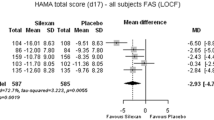Abstract
The anxiolytic activity of methylclonazepam was compared to lorazepam and placebo in a double-blind, randomized cross-over study, using a latin square design, in 18 inpatients meeting Research Diagnostic Criteria for Generalized Anxiety Disorders. Patients presented at least 1 year of symptomatology and had a minimum score of 20 on the Hamilton Anxiety Scale, despite chronic anxiolytic pharmacotherapy. Daily dosage was flexible, from three to six tablets of methylclonazepam 1 mg, lorazepam 2.5 mg, or placebo. Clinical evaluation included Hamilton Anxiety Scale, Clinical Global Impression (CGI), a side-effects checklist, completed every 2 days, and the global preference of the patient for one of the treatment periods.
Results showed a highly significant superiority of both benzodiazepines over placebo on the Hamilton Scale (P<0.000001) and CGI (P<0.001), and also a significant superiority of methylclonazepam over lorazepam on the Hamilton Scale (P<0.01), CGI-1 (P<0.01), and in the number of patient preferences (14 versus 1; P<0.001), with no significant differences in side-effects or related to position in the trial. These results support the value of the cross-over design in chronic and severe anxious inpatients for the demonstration of differences in efficacy between anxiolytic pharmacotherapies.
Similar content being viewed by others
References
Ansseau M, Doumont A, Diricq St (1984a) Methodology required to show clinical differences between benzodiazepines. Curr Med Res 8 (suppl 4):108–114
Ansseau M, Doumont A, von Frenckell R, Collard J (1984b) A long-acting benzodiazepine is more effective in divided doses. N Engl J Med 310:526
Ansseau M, Doumont A, von Frenckell R, Collard J (1984c) Duration of benzodiazepine clinical activity: Lack of direct relationship with plasma half-life. Psychopharmacology 84:293–298
Aranko K, Mattila MJ, Seppälä T (1983) Development of tolerance and cross-tolerance to the psychomotor actions of lorazepam and diazepam in man. Br J Clin Pharmacol 15:545–552
Baskin I, Esdale A (1982) Is chlordiazepoxide the rational choice among benzodiazepines? Pharmacotherapy 2:110–119
Bellantuono C, Reggi V, Tognoni G, Garattini S (1980) Benzodiazepines: Clinical pharmacology and therapeutic use. Drugs 19:195–219
Blackwell B (1976) Treatment adherence. Br J Psychiatry 129:513–531
Bobon J, Collard J, Kerf J (1962) Tranquillisants et placebo: Une étude “double-blind”. Rev Méd Liège 17:9–14
Chouinard G, Labonte A, Fontaine R, Annable L (1983) New concepts in benzodiazepine therapy: Rebound anxiety and new indications for the most potent benzodiazepines. Prog Neuro-Psychopharmacol Biol Psychiatry 7:669–673
Deberdt R (1974) Treatment of obsessional and phobic neuroses with Ro 5-3350. Medikon 3:27–29
Editorial (1977) Choice of a benzodiazepine for treatment of anxiety or insomnia. Med Lett Drugs Ther 19: 49–50
Editorial (1978) Therapeutic differences between benzodiazepines. Drug Ther Bull 16: 46–48
Fontaine R, Annable L, Chouinard G, Ogilvie RI (1983) Bromazepam and diazepam in generalized anxiety: A placebo-controlled study with measurement of drug plasma concentrations. J Clin Psychopharmacol 3:80–87
Goldberg HL (1984) Benzodiazepine and nonbenzodiazepine anxiolytics. Psychopathology (suppl 1) 17:45–55
Greenblatt DJ, Divoll M, Abernethy DR, Ochs HR, Shader RI (1983a) Benzodiazepine kinetics: Implications for therapeutics and pharmacogeriatrics. Drug Metab Rev 14:251–292
Greenblatt DJ, Shader RI, Abernethy DR (1983b) Current status of benzodiazepines. N Engl J Med 309:354–358
Guy W (ed) (1976) ECDEU Assessment Manual for Psychopharmacology (revised). Rockville, Md: National Institute of Mental Health, Psychopharmacology Research Branch
Hamilton M (1959) The assessment of anxiety states by ratings. Br J Med Psychol 32:50–55
Hills M, Armitage P (1979) The two-period cross-over clinical trial. Br J Clin Pharmacol 8:7–20
Hollister LE (1978) Antianxiety drugs. In: Clinical pharmacology of psychotherapeutic drugs. New York: Churchill Livingstone, pp 12–49
Kellner R, Uhlenhuth EH, Glass RM (1978) Clinical evaluation of antianxiety agents: Subject-own-control designs. In: Lipton MA, DiMascio A, Killam KF (eds) Psychopharmacology: A generation of progress. New York: Raven Press, pp 1391–1400
Kesson CM, Gray JMB, Lawson DH (1976) Benzodiazepine drugs in general medical patients. Br Med J i:680–682
Lader M, Petursson H (1983) Rational use of anxiolytic/sedative drugs. Drugs 25:514–528
Lapierre YD (1983) Are all benzodiazepines clinically equivalent? Prog Neuro-Psychopharmacol Biol Psychiatry 7:641–646
Mellinger GD, Balter MB, Uhlenhuth EH (1984) Prevalence and correlates of the long term regular use of anxiolytics. JAMA 251:375–379
Miller RD, Strickland R, Davidson J, Parrott R (1983) Characteristics of schizophrenics and depressed patients excluded from clinical research. Am J Psychiatry 140:1205–1207
Möhler H, Richards JG (1983) Benzodiazepines receptors in the central nervous system. In: Costa E (ed) The benzodiazepines: From molecular biology to clinical practice. New York:Raven Press, pp 93–116
Rickels K, Lipman RS, Park LC, Covi L, Uhlenhuth EH, Mock JE (1971) Drug, doctor warmth and clinic setting in the symptomatic response to minor tranquilizers. Psychopharmacologia 20:128–152
Rickels K (1983) Benzodiazepines in the treatment of anxiety: North American experiences. In: Costa E (ed) The benzodiazepines: From molecular biology to clinical practice. New York: Raven Press, pp 1–6
Sellers EM (1978) Clinical pharmacology and therapeutics of benzodiazepines. Can Med Asoc J 118:1533–1538
Solomon K, Hart T (1978) Pitfalls and prospects in clinical research on antianxiety drugs: Benzodiazepines and placebo — A research review. J Clin Psychiatry 39:823–831
Sonne LM, Holm P (1975) A comparison between bromazepam (Ro 5-3550, Lexotan) and diazepam (Valium) in anxiety neurosis. Int Pharmacopsychiatry 10:125–128
Spitzer RD, Endicott J, Robins E (1978) Research Diagnostic Criteria: Rationale and reliability. Arch Gen Psychiatry 34:773–782
Sternbach LH (1983) The discovery of CNS active 1, 4-benzodiazepines. In: Costa E (ed) The benzodiazepines: From molecular biology to clinical practice. New York: Raven Press, pp 1–6
Straw RN (1983) Implications of benzodiazepine prescribing. In: Trimble MR (ed) Benzodiazepines divided: A multidisciplinary review Chichester: John Wiley and Sons, pp 67–85
Uhlenhuth EH, Glass RM, Fischman MW (1979) Multiple cross-over designs with an antianxiety agent and an antidepressant. Psychopharmacol Bull 15 (3):37–40
Author information
Authors and Affiliations
Rights and permissions
About this article
Cite this article
Ansseau, M., Doumont, A., Thiry, D. et al. Initial study of methylclonazepam in generalized anxiety disorder. Psychopharmacology 87, 130–135 (1985). https://doi.org/10.1007/BF00431795
Received:
Accepted:
Issue Date:
DOI: https://doi.org/10.1007/BF00431795




